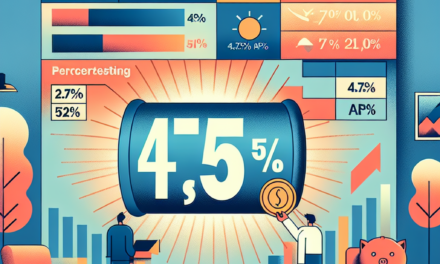“Navigating Uncertainty: Trump’s Strategies and Fed Cuts Stir Bond Market Waves”
Introduction
In the complex landscape of global finance, the bond market often serves as a barometer for economic sentiment, reflecting investor confidence and expectations for future growth. Recently, the bond market has been experiencing a period of uncertainty, marked by a tentative rebound influenced by a confluence of political and economic factors. Central to this dynamic are the policy maneuvers of former President Donald Trump and the strategic interest rate cuts implemented by the Federal Reserve. Trump’s economic plans, characterized by tax reforms and infrastructure spending, have injected a degree of optimism into the market, yet also introduced volatility as investors weigh the long-term implications of increased fiscal stimulus. Simultaneously, the Federal Reserve’s decision to lower interest rates aims to sustain economic expansion, but it also signals concerns about potential slowdowns. This interplay between political initiatives and monetary policy adjustments creates a complex environment for bonds, as investors navigate the dual forces of potential growth and underlying economic uncertainties.
Impact Of Trump’s Economic Policies On Bond Markets
The bond market, a critical component of the global financial system, has been experiencing a period of uncertainty, largely influenced by the economic policies of former President Donald Trump and recent actions by the Federal Reserve. As investors navigate this complex landscape, understanding the interplay between these factors is essential for making informed decisions.
During Trump’s presidency, a series of economic policies were implemented with the intention of stimulating growth and revitalizing American industry. Tax cuts, deregulation, and a focus on domestic manufacturing were central to his economic agenda. While these measures were designed to boost economic activity, they also had significant implications for the bond market. Tax cuts, for instance, led to increased government borrowing to finance the resulting budget deficits. This surge in borrowing raised concerns about the long-term sustainability of U.S. debt, which in turn affected investor confidence in government bonds.
Moreover, Trump’s trade policies, particularly the imposition of tariffs on Chinese goods, introduced additional volatility into the bond market. The trade tensions created uncertainty about global economic growth, prompting investors to seek safe-haven assets such as U.S. Treasury bonds. This increased demand initially drove bond prices up and yields down. However, the ongoing trade disputes also raised fears of inflationary pressures, which could lead to higher interest rates and, consequently, lower bond prices.
In parallel, the Federal Reserve’s monetary policy decisions have played a crucial role in shaping the bond market’s trajectory. In response to economic slowdowns and external shocks, the Fed has implemented a series of interest rate cuts. These rate cuts are intended to lower borrowing costs, stimulate investment, and support economic growth. However, they also have a direct impact on bond yields. When the Fed reduces interest rates, the yields on newly issued bonds typically decrease, making existing bonds with higher yields more attractive to investors.
The interplay between Trump’s economic policies and the Fed’s rate cuts has created a complex environment for bond investors. On one hand, the prospect of continued fiscal stimulus and low interest rates could support economic growth, potentially benefiting corporate bonds as companies experience improved profitability. On the other hand, the uncertainty surrounding trade policies and the long-term implications of increased government borrowing could weigh on investor sentiment, particularly in the government bond market.
As investors assess the potential for a bond market rebound, they must consider several factors. The trajectory of U.S. economic growth, influenced by both fiscal and monetary policies, will be a key determinant. Additionally, geopolitical developments, such as trade negotiations and international relations, will continue to impact market dynamics. Investors must also remain vigilant regarding inflationary pressures, as rising inflation could prompt the Fed to reverse its accommodative stance, leading to higher interest rates and lower bond prices.
In conclusion, the bond market’s future remains uncertain amid the interplay of Trump’s economic policies and the Federal Reserve’s rate cuts. While opportunities for a rebound exist, they are tempered by the complexities of fiscal and monetary policy interactions and the broader global economic environment. Investors must navigate this landscape with caution, balancing the potential for growth against the risks of volatility and uncertainty. As the situation evolves, staying informed and adaptable will be crucial for those seeking to capitalize on opportunities within the bond market.
Analyzing The Fed’s Rate Cuts And Their Influence On Bonds
The financial landscape is currently characterized by a complex interplay of factors, with the Federal Reserve’s recent rate cuts and former President Donald Trump’s economic plans at the forefront. These elements have created an environment of uncertainty, particularly in the bond market, which is traditionally sensitive to interest rate changes. Understanding the implications of these developments requires a nuanced analysis of how rate cuts influence bond yields and prices, as well as the broader economic context shaped by political strategies.
The Federal Reserve’s decision to cut interest rates is typically aimed at stimulating economic growth by making borrowing cheaper, thereby encouraging spending and investment. In theory, lower interest rates should lead to a decrease in bond yields, as investors seek higher returns elsewhere, such as in equities. However, the current scenario is more complicated. While the Fed’s rate cuts are intended to provide a cushion against economic slowdowns, they also reflect concerns about underlying economic weaknesses, which can lead to increased demand for the relative safety of bonds. This paradoxical situation can result in a bond market rebound, as investors flock to bonds as a safe haven, despite the lower yields.
Moreover, the bond market’s response is further complicated by the political landscape, particularly the economic policies proposed by Donald Trump. His plans, which often emphasize tax cuts and deregulation, aim to boost economic growth and corporate profitability. While these measures can be beneficial for the stock market, they may also lead to increased government borrowing to finance budget deficits, thereby exerting upward pressure on bond yields. This potential increase in yields could counteract the effects of the Fed’s rate cuts, creating a volatile environment for bond investors.
In addition to these domestic factors, global economic conditions also play a crucial role in shaping the bond market’s trajectory. With many central banks around the world adopting accommodative monetary policies, there is a global trend towards lower interest rates. This international context can influence U.S. bond yields, as foreign investors seek higher returns in the American market, thereby driving up demand for U.S. bonds and potentially lowering yields further.
Furthermore, the interplay between inflation expectations and bond prices cannot be overlooked. The Fed’s rate cuts are partly a response to persistently low inflation, which has remained below the central bank’s target. If inflation expectations were to rise, perhaps due to increased fiscal spending or supply chain disruptions, this could lead to higher bond yields as investors demand greater compensation for the eroding purchasing power of their fixed-income investments.
In conclusion, the bond market’s response to the Federal Reserve’s rate cuts and Donald Trump’s economic plans is far from straightforward. While lower interest rates generally lead to lower bond yields, the current environment is marked by a confluence of factors that could lead to a bond market rebound. Investors must navigate this uncertainty by considering not only domestic monetary and fiscal policies but also global economic trends and inflation expectations. As these dynamics continue to evolve, the bond market will remain a critical barometer of economic sentiment and a key area of focus for policymakers and investors alike.
Uncertainty In Bond Markets: A Closer Look At Trump’s Plans
The bond market, a cornerstone of global finance, is currently navigating a landscape fraught with uncertainty. This uncertainty is largely driven by the interplay of political maneuvers and monetary policy adjustments. At the heart of this complex scenario are the plans of former President Donald Trump, whose influence on economic policy continues to reverberate, and the Federal Reserve’s recent decisions to cut interest rates. Together, these factors create a dynamic environment that investors must carefully analyze to make informed decisions.
To begin with, the bond market’s sensitivity to political developments cannot be overstated. Former President Trump’s economic policies, characterized by tax cuts and deregulation, have historically impacted market dynamics. As Trump hints at potential future plans, including a possible return to the political arena, investors are left speculating about the implications for fiscal policy. Such speculation can lead to volatility in bond yields, as market participants attempt to anticipate shifts in government spending and taxation that could influence inflation and economic growth.
Simultaneously, the Federal Reserve’s monetary policy plays a crucial role in shaping bond market conditions. The recent decision to cut interest rates is a response to various economic challenges, including slowing growth and global uncertainties. Lower interest rates generally lead to higher bond prices, as existing bonds with higher yields become more attractive. However, the effectiveness of rate cuts in stimulating economic activity remains a topic of debate among economists. While some argue that lower rates can spur borrowing and investment, others caution that they may not be sufficient to counteract broader economic headwinds.
In this context, the bond market’s reaction to these developments is complex. On one hand, the prospect of continued low interest rates could support a rebound in bond prices, offering investors a degree of stability. On the other hand, the uncertainty surrounding Trump’s potential policy initiatives introduces an element of risk. Investors must weigh the possibility of increased fiscal spending, which could lead to higher inflation and, consequently, rising bond yields. This delicate balance between monetary policy and political uncertainty creates a challenging environment for market participants.
Moreover, the global economic landscape adds another layer of complexity to the bond market’s outlook. Trade tensions, geopolitical risks, and the ongoing impact of the COVID-19 pandemic all contribute to an environment of heightened uncertainty. These factors can influence investor sentiment and lead to fluctuations in bond prices as market participants reassess their risk exposure. In such a volatile environment, diversification and risk management become essential strategies for investors seeking to navigate the bond market’s uncertainties.
In conclusion, the bond market is currently at a crossroads, influenced by the interplay of Trump’s potential policy plans and the Federal Reserve’s rate cuts. While lower interest rates may provide some support for bond prices, the uncertainty surrounding future fiscal policies introduces significant risks. Investors must remain vigilant, closely monitoring political developments and economic indicators to make informed decisions. As the global economic landscape continues to evolve, the bond market’s path forward remains uncertain, underscoring the need for careful analysis and strategic planning.
The Relationship Between Fed Rate Cuts And Bond Yields
The intricate relationship between Federal Reserve rate cuts and bond yields has long been a subject of interest for economists and investors alike. This dynamic interplay becomes particularly significant in times of economic uncertainty, such as the current period marked by former President Donald Trump’s economic plans and the Federal Reserve’s recent decisions to cut interest rates. Understanding how these elements interact is crucial for predicting potential movements in the bond market and making informed investment decisions.
To begin with, it is essential to comprehend the fundamental mechanics of how Federal Reserve rate cuts influence bond yields. Typically, when the Federal Reserve reduces interest rates, it aims to stimulate economic activity by making borrowing cheaper for consumers and businesses. This, in turn, can lead to increased spending and investment, fostering economic growth. However, the impact on bond yields is somewhat counterintuitive. Lower interest rates generally lead to a decrease in bond yields. This is because as rates fall, existing bonds with higher interest payments become more attractive, driving up their prices and inversely causing yields to drop.
In the context of Trump’s economic plans, the situation becomes more complex. His proposals often focus on tax cuts, deregulation, and infrastructure spending, which are designed to boost economic growth. While these measures can potentially lead to higher inflation and increased government borrowing, they also create an environment where the Federal Reserve might feel compelled to adjust its monetary policy. If the economy overheats due to these fiscal policies, the Fed might consider raising rates to keep inflation in check, which could lead to higher bond yields.
However, the current scenario is marked by the Fed’s decision to cut rates, a move that reflects concerns about slowing economic growth and global uncertainties. This decision is influenced by various factors, including trade tensions, geopolitical risks, and sluggish global economic performance. In such a climate, the Fed’s rate cuts are intended to provide a cushion against potential downturns, but they also contribute to the downward pressure on bond yields.
Moreover, the bond market’s response to these developments is not always straightforward. Investors’ expectations play a crucial role in determining bond yields. If market participants anticipate that the Fed’s rate cuts will successfully stimulate the economy, they might expect future rate hikes, which could lead to an increase in bond yields. Conversely, if investors believe that the rate cuts are insufficient to counteract economic headwinds, they might seek the safety of bonds, driving yields lower.
In addition, the global context cannot be ignored. With many central banks around the world also adopting accommodative monetary policies, the international demand for U.S. bonds can influence yields. When foreign investors seek the relative safety of U.S. Treasuries, it can lead to increased demand and further downward pressure on yields.
In conclusion, the relationship between Federal Reserve rate cuts and bond yields is a complex and multifaceted one, influenced by a myriad of factors including domestic fiscal policies, global economic conditions, and investor sentiment. As Trump’s economic plans unfold and the Fed continues to navigate the challenges of the current economic landscape, the bond market remains in a state of uncertainty. Investors must remain vigilant, considering both domestic and international developments, to navigate this intricate financial environment effectively.
How Political Uncertainty Affects Bond Market Stability
The bond market, often seen as a barometer of economic stability, is currently navigating a landscape fraught with uncertainty. This volatility is largely driven by the interplay of political developments and monetary policy decisions. In particular, the potential rebound of bonds is being closely watched in light of former President Donald Trump’s plans to re-enter the political arena and the Federal Reserve’s recent rate cuts. These factors are creating a complex environment for investors, who must weigh the implications of political uncertainty against the backdrop of shifting economic policies.
Political uncertainty has long been a significant factor influencing bond market stability. The prospect of Donald Trump’s return to the political stage adds a layer of unpredictability, as his policies and rhetoric have historically had profound impacts on financial markets. Investors are keenly aware that Trump’s potential candidacy could lead to shifts in fiscal policy, trade relations, and regulatory frameworks. These changes could, in turn, affect the economic outlook and, consequently, bond yields. As investors attempt to anticipate these developments, the bond market may experience heightened volatility, with prices fluctuating in response to political news and speculation.
Simultaneously, the Federal Reserve’s monetary policy decisions are playing a crucial role in shaping the bond market’s trajectory. The recent rate cuts, aimed at stimulating economic growth, have introduced another variable into the equation. Lower interest rates generally lead to higher bond prices, as existing bonds with higher yields become more attractive to investors. However, the effectiveness of these rate cuts in stabilizing the bond market is contingent upon broader economic conditions and investor sentiment. If the market perceives the rate cuts as insufficient to counteract economic headwinds, the anticipated bond rebound may not materialize as expected.
Moreover, the interaction between political uncertainty and monetary policy further complicates the bond market’s outlook. For instance, if Trump’s political maneuvers lead to increased fiscal spending or changes in trade policy, the Federal Reserve may need to adjust its monetary stance to accommodate these shifts. Such adjustments could include altering the pace of rate cuts or implementing other measures to maintain economic stability. This dynamic interplay between fiscal and monetary policy creates a challenging environment for bond investors, who must remain vigilant and adaptable in the face of evolving circumstances.
In addition to these domestic factors, global economic conditions also play a role in influencing bond market stability. Geopolitical tensions, trade disputes, and economic slowdowns in key markets can all impact investor confidence and, by extension, bond prices. As a result, the bond market’s potential rebound is not solely dependent on U.S. political and monetary developments but is also influenced by a myriad of international factors. Investors must therefore adopt a comprehensive approach, considering both domestic and global elements when assessing the bond market’s prospects.
In conclusion, the bond market’s stability is currently subject to a confluence of political and economic factors. The uncertainty surrounding Donald Trump’s political ambitions, coupled with the Federal Reserve’s rate cuts, creates a complex environment for investors. As they navigate this landscape, the interplay between political developments, monetary policy, and global economic conditions will be crucial in determining the bond market’s trajectory. While the potential for a bond rebound exists, it is contingent upon a delicate balance of these factors, requiring investors to remain informed and agile in their decision-making processes.
Strategies For Investors Amid Uncertain Bond Rebound
In the current financial landscape, investors are navigating a complex environment characterized by uncertainty in the bond market, influenced by former President Donald Trump’s economic plans and recent Federal Reserve rate cuts. As these factors interplay, investors are left to strategize their portfolios amidst fluctuating yields and unpredictable market conditions. Understanding the nuances of these developments is crucial for making informed investment decisions.
The bond market, traditionally seen as a safe haven for investors seeking stability, has been experiencing volatility due to a confluence of political and economic factors. Former President Trump’s economic policies, which include tax reforms and infrastructure spending, have historically aimed to stimulate growth. However, these measures also carry the potential to increase inflationary pressures, which can adversely affect bond prices. As inflation expectations rise, bond yields typically follow suit, leading to a decrease in bond prices. This inverse relationship between bond prices and yields is a fundamental concept that investors must consider when evaluating their bond investments.
Simultaneously, the Federal Reserve’s recent rate cuts add another layer of complexity to the bond market. Lower interest rates generally lead to lower yields on newly issued bonds, which can make existing bonds with higher yields more attractive. However, the Fed’s actions are often a response to broader economic concerns, such as slowing growth or geopolitical tensions, which can introduce additional risks into the market. Investors must weigh the benefits of potentially higher returns from existing bonds against the backdrop of an uncertain economic outlook.
In light of these dynamics, investors are advised to adopt a diversified approach to their bond portfolios. Diversification can help mitigate risks associated with interest rate fluctuations and inflationary pressures. By spreading investments across various bond types, such as government, corporate, and municipal bonds, investors can reduce their exposure to any single economic event or policy change. Additionally, considering bonds with different maturities can provide a balance between short-term liquidity needs and long-term growth objectives.
Moreover, investors should remain vigilant and informed about ongoing economic developments and policy changes. Keeping abreast of Federal Reserve announcements and government policy shifts can provide valuable insights into potential market movements. This proactive approach allows investors to adjust their strategies in response to changing conditions, thereby enhancing their ability to protect and grow their investments.
Another strategy to consider is the inclusion of inflation-protected securities, such as Treasury Inflation-Protected Securities (TIPS), in the investment portfolio. These instruments are designed to safeguard against inflation by adjusting their principal value in line with inflation rates. As a result, they can offer a hedge against the erosion of purchasing power, which is particularly relevant in an environment where inflationary pressures may rise due to expansive fiscal policies.
In conclusion, the uncertain bond rebound amid Trump’s plans and Fed rate cuts presents both challenges and opportunities for investors. By understanding the interplay between these factors and employing strategic diversification, investors can navigate the complexities of the bond market with greater confidence. Staying informed and adaptable will be key to successfully managing investments in this evolving economic landscape. As always, consulting with financial advisors and conducting thorough research will further enhance the ability to make sound investment decisions in these uncertain times.
The Future Of Bonds In A Volatile Economic Environment
In the current economic landscape, the bond market finds itself at a crossroads, influenced by a confluence of factors that include former President Donald Trump’s economic plans and the Federal Reserve’s recent rate cuts. As investors navigate this volatile environment, the future of bonds remains uncertain, with potential rebounds hinging on a variety of economic indicators and policy decisions. To understand the complexities of this situation, it is essential to examine the interplay between these elements and their implications for the bond market.
Firstly, the Federal Reserve’s decision to cut interest rates has been a significant factor in shaping the bond market’s trajectory. Lower interest rates generally lead to higher bond prices, as existing bonds with higher yields become more attractive to investors. However, the current rate cuts are part of a broader strategy to stimulate economic growth amid concerns of a slowing economy. While this monetary policy aims to encourage borrowing and investment, it also raises questions about the long-term sustainability of such measures. Investors are left to ponder whether these rate cuts will indeed spur economic activity or merely provide a temporary boost to bond prices.
Simultaneously, former President Trump’s economic plans continue to exert influence over market dynamics. His policies, characterized by tax cuts and deregulation, have historically aimed to stimulate economic growth. However, the potential for increased government spending and rising deficits under such plans could lead to inflationary pressures. Inflation, in turn, poses a threat to bondholders, as it erodes the purchasing power of fixed-income returns. Consequently, investors must weigh the potential benefits of economic growth against the risks of inflation when considering their bond portfolios.
Moreover, the global economic environment adds another layer of complexity to the bond market’s future. Trade tensions, geopolitical uncertainties, and fluctuating commodity prices all contribute to a volatile backdrop that can impact investor sentiment and bond yields. In such an environment, safe-haven assets like U.S. Treasury bonds often become more attractive, driving up demand and prices. However, this flight to safety can be short-lived if economic conditions stabilize or if other investment opportunities present themselves.
In light of these factors, the bond market’s potential rebound remains uncertain. Investors must remain vigilant, closely monitoring economic indicators such as inflation rates, employment figures, and GDP growth. Additionally, the Federal Reserve’s future policy decisions will be critical in shaping the bond market’s direction. Any signals of further rate cuts or shifts in monetary policy could have significant implications for bond yields and investor strategies.
Furthermore, diversification becomes a key consideration for investors seeking to navigate this uncertain environment. By spreading investments across different types of bonds, such as corporate, municipal, and international bonds, investors can mitigate risks associated with any single economic or policy development. This approach allows for a more balanced portfolio that can better withstand the ebbs and flows of a volatile market.
In conclusion, the future of bonds in this volatile economic environment is fraught with uncertainty. The interplay between Trump’s economic plans, Federal Reserve rate cuts, and global economic conditions creates a complex landscape for investors to navigate. While potential rebounds in the bond market are possible, they are contingent upon a myriad of factors that require careful analysis and strategic decision-making. As such, investors must remain informed and adaptable, ready to adjust their strategies in response to evolving economic and policy developments.
Q&A
1. **What is the current state of the bond market amid Trump’s plans and Fed rate cuts?**
The bond market is experiencing uncertainty as investors weigh the impact of President Trump’s economic policies and the Federal Reserve’s interest rate cuts.
2. **How are Trump’s economic plans affecting the bond market?**
Trump’s plans, including tax cuts and infrastructure spending, are creating mixed signals for the bond market, with potential for both economic growth and increased fiscal deficits.
3. **What role do Fed rate cuts play in the bond market’s uncertainty?**
Fed rate cuts typically lower borrowing costs and can stimulate economic activity, but they also signal concerns about economic slowdown, contributing to bond market volatility.
4. **Are investors optimistic about a bond market rebound?**
Investor sentiment is mixed, with some optimistic about a rebound due to potential economic growth, while others remain cautious due to ongoing uncertainties.
5. **How are interest rates influencing bond prices?**
Lower interest rates generally lead to higher bond prices, but the current uncertainty is causing fluctuations as investors react to economic data and policy announcements.
6. **What are the potential risks for the bond market?**
Risks include potential inflation from fiscal policies, geopolitical tensions, and the possibility of a slower-than-expected economic recovery.
7. **What strategies are investors using to navigate the uncertain bond market?**
Investors are diversifying their portfolios, focusing on high-quality bonds, and closely monitoring economic indicators and policy developments to manage risk.
Conclusion
The uncertain bond rebound amid Trump’s plans and Fed rate cuts reflects a complex financial landscape where investor sentiment is influenced by both political and economic factors. Trump’s policy proposals, which may include fiscal stimulus or regulatory changes, can create volatility and uncertainty in the bond market as investors assess potential impacts on economic growth and inflation. Simultaneously, the Federal Reserve’s rate cuts aim to stimulate the economy by lowering borrowing costs, which typically supports bond prices. However, the effectiveness of these cuts in achieving desired economic outcomes can be uncertain, especially if market participants are skeptical about future growth prospects or if geopolitical tensions arise. Consequently, the bond market’s response is characterized by fluctuations as investors weigh these competing influences, leading to a rebound that is tentative and subject to change based on evolving economic and political developments.





